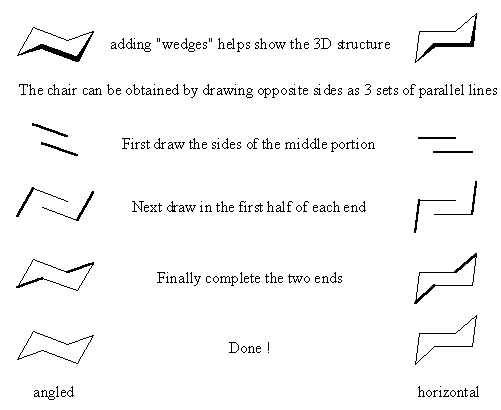| Chapter 3: Conformations of Alkanes and Cycloalkanes |
| Chapter 3: Conformations of Alkanes and Cycloalkanes |
Drawing and Understanding Diagrams
The ability to draw and interpret the different diagrams that are used to represent the different conformations is an important skill to acquire. Maximise your artistic talents ! The only person that will be decieved by your poor diagrams is you ! Your instructor will be able to tell instantly that you are struggling....
These diagrams allow 3D representations
of molecules to be drawn on the 2D world of a piece of paper (or computer screen),
in a similar way to which one can look at the plans for a house.
| wedge-dash | sawhorse | Newman | cyclohexane |
Wedge-dash diagrams
Usually drawn with two bonds in the plane of the page, one infront, and one
behind to give the molecule perspective. When drawing wedge-dash it is a good
idea to visualise the tetrahedral arrangement of the groups and try to make
the diagram "fit" this. As a suggestion, they seem to be most effective when
the "similar" pairs of bonds (2-in-plane, 2-out-of-plane) are next to each other,
see below:

Sawhorse
 Sawhorse diagrams are similar to wedge-dash diagrams, but without
trying to use "shading" to denote the perspective. The representation to the
right of propane has been drawn so that we are looking at the molecule which
is below us and to our left.
Sawhorse diagrams are similar to wedge-dash diagrams, but without
trying to use "shading" to denote the perspective. The representation to the
right of propane has been drawn so that we are looking at the molecule which
is below us and to our left.
 These
projections are drawn by looking directly along a particular bond in the system
(here a C-C bond) and arranging the substituents symmetrically around the atoms
at each end of that bond. The protocol requires that the atoms within the central
bond are defined as shown below:
These
projections are drawn by looking directly along a particular bond in the system
(here a C-C bond) and arranging the substituents symmetrically around the atoms
at each end of that bond. The protocol requires that the atoms within the central
bond are defined as shown below:

In order to draw a Newman projection from a wedge-dash diagram, it is useful to imagine putting your "eye" in line with the central bond in order to look along it.
Let's work through an example, consider drawing a Newman projection by looking at the following wedge-dash diagram of propane from the left hand side.

Drawing Cyclohexanes
Drawing cyclohexane so that it looks like a chair can be the key to appreciating
the axial and equatorial positions. If you are unable to draw good looking structures
that clearly show axial and equatorial positions, then your instructor is probably
going to assume that you don't know.
By not mastering the trick of drawing cyclohexanes the only person that really suffers is you the student. You deprive yourself of the knowledge and the chance to appreciate it and what it means. Believe me, it will be needed later.
The first step is drawing the chair itself. Although the chair "looks better" when slightly angled, it maybe easier to "learn" to draw it with the middle portion horizontal.

| © Dr. Ian Hunt, Department of Chemistry, University of Calgary |